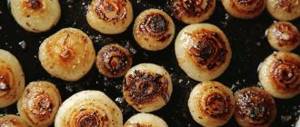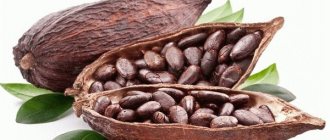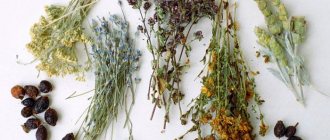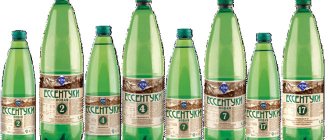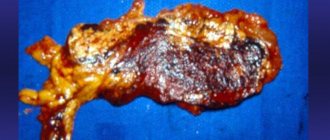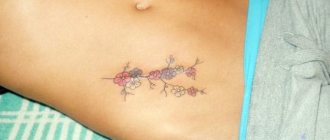Home Ι The harm of alcohol
The gallbladder is a small organ located in the central part of the peritoneum. It serves as a temporary container for bile, which is synthesized by the liver, a large gland located just above. This organ itself is not one of the vital organs, therefore, in case of serious damage to its tissues, it is often completely removed.
During the recovery period after surgery, a person will face many restrictions. Some of them remain relevant throughout life, since the liver will be subject to enormous stress. Mostly fatty and heavy foods, as well as alcohol, are prohibited. It is these products that can provoke serious damage to the organ.
Causes of gallbladder diseases
The gall sac itself does not secrete any enzymes or hormones. It is a kind of reservoir for bile. The duct of this small organ opens into the lumen of the duodenum. Next to it there is a channel through which pancreatic juice secreted by the pancreas enters there.
The gallbladder, like any other organ, is subject to pathological changes, the causes of which are most often poor nutrition and an inactive lifestyle. If a person is used to eating outside the home, on the run, often refusing liquid meals, but eating sandwiches in abundance, then problems are unlikely to be avoided. The situation is aggravated if at the end of the day you take a lot of heavy food at once, including fried, fatty, smoked food.
When dieting is not done, the liver is forced to produce too much bile. Its excess accumulates in the bubble located below, which provokes stagnant processes. It is they who ultimately cause the development of pathologies.
As a rule, gallstone disease is most often diagnosed. This is a condition in which the organ itself and its excretory duct become clogged with foreign particles of different sizes. Sand and stones can accumulate inside the bladder, blocking the free flow of bile, which further aggravates the situation. Bacteria penetrate inside the gallbladder, causing inflammation and gradual tissue death. After this, the organ can no longer function normally. It is possible to suspect the appearance of stones based on the following signs:
- abdominal pain, mainly on the right side;
- nausea;
- vomit;
- heaviness in the stomach;
- bowel disorders.
Such symptoms cause inconvenience, so a person rushes to seek medical help. If the doctor diagnoses a pathology of the gallbladder, then measures will be taken immediately. This is due to the fact that the stones present stretch the walls of the bag, and this can lead to mechanical damage. If accumulated bile enters the abdominal cavity, there is a high probability of inflammation spreading. This cannot be allowed.
Doctors explain that the patient’s life will continue without the gallbladder, so this organ will be surgically removed. Of course, such interference cannot go unnoticed. The human body will adapt to a new mode of operation. Adaptation will be successful if all the surgeon’s instructions are strictly followed during the recovery period.
Important! Many rules will have to be followed throughout your life. These include dietary recommendations. The main goal is to reduce the load on the liver, since the bile it produces will now flow directly into the small intestine, bypassing the temporary storage reservoir.
Consequences of drinking alcohol
Since this disease is associated with complications of the digestive system, it is naive to think that its use will not in any way affect the performance of this system. First, the emergence of pathogenic microflora will lead to inflammation, which can spread to the pancreas. As a result of obstruction of the canals, deterioration of the condition in the stomach and duodenum may occur.
The next manifestation may be an increase in the production of hydrochloric acid and contributing to the development of reflux. It manifests itself in the form of ejection of contents into the esophagus and its irritation.
Regarding red wine for cholecystitis, it has both positive and negative effects. It is credited with antitumor properties. It is considered very useful, as it contains resveratrol and other beneficial components. When fermenting grape juice, their quantity does not decrease, but rather increases. But about the amount of its use to obtain a positive effect, it is worth consulting with a specialist.
INTERESTING fact: Can Arbidol be taken with alcohol?
Among the large selection of grape alcoholic drinks, it is advisable to give preference to dry wine for cholecystitis, since it does not contain sugar or other ingredients. Remember that anything too much is not healthy.
Be healthy!
The most important changes in the body
Any surgery undergone is stressful for the whole body. In this case we are talking about the complete liquidation of an organ. This means that all its functions will be distributed among other structures.
Some people who are new to anatomy and physiology are convinced that the gallbladder is one of the organs that practically does not perform any important functions. This misconception is due to the fact that life is actually possible without it. Nevertheless, the human body undergoes significant changes after the elimination of this organ.
First of all, doctors mention that bile not only provides comfortable digestion, but also has antibacterial properties.
It is this feature that makes it possible to restrain the growth of pathogenic microflora in the intestines, preventing the development of dysbiosis. This is only possible when bile enters the duodenum in sufficient quantities. The bubble serves as a reservoir for collecting it.
In its absence, a different situation arises. Bile will enter the intestinal lumen immediately after its secretion. The amount of this biological fluid will be minimal, so there is a high probability of pathogenic microbes remaining in the final sections of the gastrointestinal tract. As a result, this is fraught with frequent digestive disorders.
Typically, people with their gallbladder removed suffer from alternating diarrhea and constipation, bloating, and increased gas formation. We should not forget that all other functions relating to the secretion, storage and transportation of bile are performed by the liver and its ducts. In this regard, people often ask the question whether it is possible to drink alcoholic beverages or heavy food. Doctors agree that both options are dangerous to health, since the liver will be subjected to enormous stress.
Cholecystitis and alcohol
Is it possible to drink alcohol with acute cholecystitis? If a person has been diagnosed with this disease, then drinking alcoholic beverages is strictly prohibited. With chronic cholecystitis the situation is the same. There is an explanation for this. Alcoholic drinks provoke stagnation of bile in the bladder, which causes new stones to actively form. Another negative effect of alcohol is the narrowing of the bile ducts, which results in constant disruptions in the functioning of the biliary system.
Frequent consumption of alcohol provokes the transition of cholecystitis to a chronic form. This is due to the fact that alcoholic drinks entering the body are broken down into acetaldehyde and carbon dioxide. The first substance is a toxin that poisons the liver and the entire body as a whole.
Attention! Sometimes the cause of cholecystitis is damage to the gallbladder by pathogenic microorganisms. This will also be facilitated by the consumption of alcoholic beverages, as they disrupt the microflora of the organ.
There is another mechanism for the rapid manifestation of cholelithiasis - this is intoxication of the body, which occurs with regular consumption of alcohol. In this case, a violation of lipid metabolism occurs, as a result, the bile contains a lot of “bad” cholesterol. It is this that promotes the formation and enlargement of stones.
The bile ducts have a system of sphincters that separate them from the gallbladder. Thanks to them, bile enters the duodenum in a timely manner and the digestion process proceeds normally. When consuming even a minimal dose of alcohol, these sphincters no longer work as synchronously. As a result, the functioning of the biliary system is disrupted. Bile is excreted chaotically, in different quantities, and stagnation occurs.
When consuming fatty foods along with alcohol, bile production is increased, but the malfunction of the sphincters cannot cope fully. This leads to overstretching of the organ. Deformation of the organ and its complete filling leads to inflammation.
If the gallbladder was removed as a result of cholecystitis, then it is recommended to give up alcohol forever. Some doctors recommend not drinking alcohol for the first 2-3 years after surgery, and then you can allow yourself a small amount of wine. But it is important that beer, wine and other drinks begin to break down in the stomach and the acetaldehyde that is released severely poisons the body. Without a gallbladder, eliminating this toxin will be difficult. Therefore, intoxication of the body will be long-term with a concomitant inflammatory process in the gastrointestinal tract.
Frequent consumption of alcohol provokes the transition of cholecystitis to a chronic form
Cholecystectomy and its consequences
If the gallbladder undergoes serious pathological changes, the surgeon decides to completely remove it surgically. This operation is called cholecystectomy. The procedure has a number of unpleasant consequences, so the patient should be warned about possible complications.
The manipulation itself can be carried out in two different ways. The first option uses the traditional open method, in which an incision is made on the right side of the abdomen through all layers of the epidermis. Next, the skin is pulled apart with special clamps, and the damaged bladder itself is removed from the abdominal cavity. Sutures are placed on the internal ducts. After stopping local bleeding and complete sanitation, the layers of the epidermis are sutured.
Removal of the bladder is also possible during laparoscopy. In this case, three small incisions are made on the patient’s abdomen, through one of which the damaged organ is removed. The operation is performed in a closed manner under the control of an ultrasound machine. Its obvious advantage is the rapid healing of wounds, since only three small sutures remain on the surface of the skin at the sites where the laparoscope is inserted.
After removal of an organ, negative consequences for the body are possible. Doctors mention the development of postcholecystectomy syndrome. This is a condition in which a person suffers from pain in the right hypochondrium, heaviness in the abdomen, and bloating. In the most severe cases, a person’s skin acquires a characteristic yellow color, which indicates damage to the liver or ducts. This usually happens when the bile ducts are blocked by small stones,
that were missed during diagnostic testing or surgery.
When the reservoir for accumulation of liver secretions is removed, other pathologies may develop. A common disease is pancreatitis. This is an inflammation of the nearby pancreas. The disease is possible because its ducts are located next to the excretory canals of the gallbladder and liver. Its development can be guessed by the pain radiating to the left hypochondrium.
Indications for removal
Many circumstances and factors lead to serious problems with the gallbladder, and surgical intervention is recommended. A decrease in the motility of its walls can be caused by an inflammatory process, the appearance of areas with necrotic lesions due to infection, mechanical damage, parasite infestation, and more.
The need to remove this organ is often associated with cholecystitis, obstruction of the bile ducts, calcification, and tumors. Gallstone disease can be a cause. When polyps are found, cholecystectomy is recommended. Other methods will not help.
Is there a connection between the fact that the gallbladder is in poor condition and the fact that alcohol was sometimes consumed?
Few people know the answer to this question. Diagnostics allows you to see the state of the body at the moment.
It is difficult to find out what happened before, what kind of life a person led many years ago, and the doctor usually does not set himself such a task. It is important for him to determine what exactly hurts, help the patient recover, and find the optimal treatment option.
Proper nutrition after surgery
It doesn’t matter what exactly leads to the removal of the bubble - inflammation or a large stone. In both cases, the patient faces a serious surgical intervention, and then a long recovery period, during which certain rules must be followed. Most of them regulate the principles of constructing a diet.
If a person’s gallbladder is removed, it becomes impossible to consume certain foods. The prohibited group includes all multi-ingredient dishes, salads, seasoned with mayonnaise or other fatty sauces. Do not get carried away with salty foods, sausages, smoked meats, and canned food. They represent a significant burden for the liver, which works in an unusual mode.
Important! Doctors warn that those who consume fatty and spicy foods after undergoing cholecystectomy greatly increase the risk of developing chronic liver disease, which will be difficult to cure.
A serious threat to health is a reason to carefully plan your own menu. On the table of a person with a removed gallbladder there may be:
- light broths;
- vegetarian soups;
- porridge;
- omelettes;
- vegetables;
- fruits;
- dairy products.
The less time has passed since surgery, the more strict the diet should be. This is an individual setting. Thus, some patients eat only vegetable soups and slimy porridges for the entire first year, supplementing them with kefir or cottage cheese. Others, after about 6 months, introduce meatballs and steamed cutlets from dietary meat, as well as boiled lean fish, into the diet.
The strictest prohibition applies not to heavy food, but to alcohol. Alcohol is dangerous for the liver, which is already suffering due to increased stress. Violation of this recommendation may lead to serious health problems.
Alcohol after gallbladder removal – what do experts talk about?
Experts strongly point out that you should give up alcoholic beverages after removal of the gallbladder, and the abstinence should be for life. If the patient is not ready to give up alcohol completely, it is extremely important to abstain from it in the first stages of treatment, and only then drink in small doses, carefully monitoring the state of the body.
If deterioration is observed after drinking alcohol, it is necessary to give up salty, spicy and fatty foods, and make the diet more strict until the negative effects pass. You should eat porridge, drink low-fat broths, and vegetables. You can switch to six meals a day with a reduction in single servings, this will relieve the digestive system.
You also need to be careful about drinking. The diet should contain clean water, from 1 to 1.5 liters per day, it should be taken in equal portions throughout the day. You can also take up to two cups of lemon balm or chamomile tea, or regular tea. This approach will help minimize the consequences.
If you have any health problems after drinking alcohol, please contact our clinic immediately for help!
Liver response to alcohol consumption
Whatever alcohol-containing drink a person chooses, he will not be able to avoid its negative influence. Ethanol itself is dangerous to health, as it is quickly distributed throughout all tissues and cells of the body. A person feels slightly dizzy, as well as an uplift in mood due to the release of hormones into the blood. During this period, he does not notice that the body is already undergoing negative destructive effects.
When drinking alcohol in excess of the norm, the walls of blood vessels become toned. They narrow, causing fluid to move through them more slowly than usual and forcing the heart to work harder. The blood itself thickens due to the gluing of its formed elements together.
Alcohol also has a negative effect on the mucous membranes of the gastrointestinal tract. The inner lining of the stomach begins to collapse, since ethanol is an aggressive substance. This is a direct path to the development or exacerbation of gastritis or peptic ulcer.
The entire body is negatively affected, but the maximum load when drinking alcohol falls on the liver. It is this iron that is involved in neutralizing the products of its oxidation. At the initial stage, acetaldehyde is formed from ethanol. This is the most toxic compound that poisons the entire body and leads to the development of hangover syndrome. In the second stage, this substance is transformed into acetic acid. It is relatively harmless and does not cause harm to internal organs, but gradually leaves the body. The more actively enzymes work, the faster all dangerous compounds will leave tissues and cells.
The liver is quite vulnerable to alcohol, especially if a person regularly drinks large amounts of strong drinks. Its structural units die off, and part of the tissue simply collapses. The gland weakens and can no longer fully perform its functions. Restoration of the organ is possible, but it occurs very slowly, especially if the patient does not take any additional medications.
Alcohol after gallbladder removal - drinks, timing and dosage
Whiskey, cognac, tequila are drinks that should be avoided. High-quality vodka and red wine are considered acceptable. You should not choose drinks with dyes; you should also avoid any low-quality alcohol with fusel oils; this is extremely dangerous for an already weakened body.
After three years of rehabilitation and complete restoration of the digestive tract, you can take 50 g of vodka or 100 g of unfortified wine for six months; in the future, the dosage can be increased after six months, with the permission of the doctor. To reduce the risks of drinking alcohol, use fermented milk products, which perfectly remove toxins. It also helps to introduce a hydro regime and drink clean water without gases, which helps to quickly and gently remove the products that remain after the breakdown of alcohol. Additional safety measures, such as those listed above, can significantly reduce the risk of drinking alcohol in this state, when the body is especially vulnerable.
Ban on alcohol after surgery
The gallbladder is inextricably linked to the liver. It is here that all the bile that is formed enters before mixing with semi-digested food in the duodenum. This explains the fact that after cholecystectomy, the maximum load falls on the liver.
Doctors warn that you should not drink alcohol without a gallbladder, as the gland will be destroyed at an unusually high rate. It is entrusted not only with the function of secreting bile in a fairly large volume. The liver is directly involved in the neutralization of toxins, which are the oxidation products of ethyl alcohol.
There is another threat to a person when drinking alcohol. It has been proven that the presence of ethanol in the blood slows down the flow of bile into the intestinal lumen. This secretion is necessary for digesting food and maintaining healthy microflora, so its deficiency can lead to serious consequences. Due to stagnation of food inside the gastrointestinal tract, as well as blockage of the excretory channels, inflammatory processes develop, which are almost always accompanied by severe discomfort - pain and bloating.
At the early recovery stage after surgery, any alcohol is strictly prohibited. This is due not only to increased load on the liver, but also to a number of other reasons:
- Any type of surgery requires the use of general anesthesia. This means that the drugs used for anesthesia will remain in the patient’s blood for some time. Combining them with ethanol is extremely undesirable.
- Doctors warn that the stitches after surgery may hurt for a long time. Alcohol consumption aggravates the situation, increasing the discomfort.
- Doctors often prescribe antibiotics during the recovery period. They are needed to prevent possible inflammation. Parallel intake of ethanol and any antimicrobial agents greatly increases the load on the liver.
- After removal of the bladder, bile will enter the intestines in smaller quantities, which means a high probability of developing dysbiosis due to the rapid proliferation of pathogenic microflora within the gastrointestinal tract. Alcohol also slows down the growth of beneficial bacteria, so intestinal disorders cannot be avoided when drinking it.
All of the above indicates that to preserve your health, it is better to stop drinking alcohol. Any questions you have, including why you shouldn’t drink, can be safely asked to your doctor before or after surgery.
Why you should not drink alcohol after gallbladder removal - risks
When thinking about why alcohol should not be consumed after gallbladder removal, a person usually thinks about the risks that may arise when drinking alcohol. And in this case they really exist - it’s worth knowing about them in advance. In the absence of a gallbladder, alcohol will enter the body, bypassing the neutralization mechanism, it will decompose into acetic acid, which is extremely dangerous. In this situation, the liver and its ducts will be exposed to additional risks, and inflammation may develop. The consequences of drinking alcohol after removal of the gallbladder can be pancreatitis, cholangitis and inflammation of the ducts, and even cirrhosis of the liver. Stones may form because cholesterol can no longer be absorbed as efficiently.
Other restrictions after surgery
Cholecystectomy is a serious intervention, so restrictions in the recovery period do not end with diet correction and exclusion of alcoholic beverages from the menu. It is important to follow some other rules. This will ensure a relatively quick and comfortable recovery.
In the first hours, the patient recovers from anesthesia, so he needs bed rest. It is recommended to avoid any type of activity for the next few days. You are allowed to sit and walk, but it is important to monitor the condition of the stitches and general sensations.
If discomfort or pain develops, you need to go back to bed and seek help from a doctor. There is no guarantee that gallbladder disease will not cause complications. The sooner they are diagnosed, the higher the chances of eliminating them.
If no unpleasant sensations arise, then after the sutures are removed, you are allowed to gradually return to your usual way of life. Of course, you need to protect yourself from heavy lifting and active sports. Basically, there are no serious prohibitions. It is only important to adhere to a special diet that excludes all heavy foods and alcohol.
There is one more important nuance. After cholecystectomy, you should not limit yourself to drinking. Almost all non-alcoholic drinks can be consumed, with the exception of carbonated waters and strong coffee. The ideal option would be herbal infusions, green tea, natural juices or fruit drinks. Doctors advise paying attention to special choleretic preparations. They will be beneficial for pathology by enhancing the secretion of fluid by the liver. This will ensure the elimination of stagnant processes and timely cleansing of the gland ducts.
The effect of alcohol on the digestive system
In addition to the gallbladder, alcoholic drinks also have a negative effect on other organs of the digestive system. How is it shown:
- Saliva becomes viscous, which impairs the primary breakdown of beneficial microelements in the oral cavity.
- Alcohol abuse increases the production of hydrochloric acid in the esophagus. This leads to its reflux from the stomach back into the lower esophagus, that is, reflux.
- Under the influence of alcohol, the gastric mucosa is irritated. Over time, this leads to gastritis and even ulcers.
- Strong drinks have a negative effect on the function of the small intestine. They impair its peristalsis and blood supply. Therefore, intestinal ulcers are a common disease of people who do not know what to do.
- Pancreatitis, another disease of the gallbladder, is a consequence of addiction to the “green snake”. Three quarters of people who drink sooner or later experience this disease.
- Another organ that suffers from alcohol is the liver. If you abuse alcohol, you can encounter diseases such as cirrhosis, hepatomegaly, fatty steatosis, and hepatitis.
If, in addition, a person is sick with cholecystitis, this significantly enhances the negative effect. A whole “bouquet” of diseases is added to the main ailment, which leads to a deterioration in the quality of life and a reduction in life expectancy.
What happens to the liver when a person drinks alcohol?
In people suffering from alcohol addiction, the body is systematically exposed to the negative effects of ethanol. This substance destroys healthy liver cells, causes inflammation and disrupts the synthesis of liver enzymes. It is known that the breakdown products of alcohol, including acetaldehyde, are difficult to remove from the body, this leads to the filling of cholesterol in the liver cells and the creation of favorable conditions for the development of diseases.
Hepatocytes, although not in large numbers, are destroyed even after drinking light alcoholic beverages. At the initial stage, the liver begins to increase in size, and the amount of enzymes it produces, on the contrary, decreases. Since dysfunction of the cells of this organ occurs, the blood ceases to undergo the filtration process, and therefore the harmful substances present in it are distributed throughout the body.
The second stage of alcoholic liver damage is the development of hepatitis, in which adipose tissue replaces most of the organ. The liver acquires pale pink and yellow shades, its surface is covered with a fatty film. With the onset of cirrhosis, this organ becomes loose; during a diagnostic study, scar tissue is visualized, as well as multiple ulcers and blood clots.

